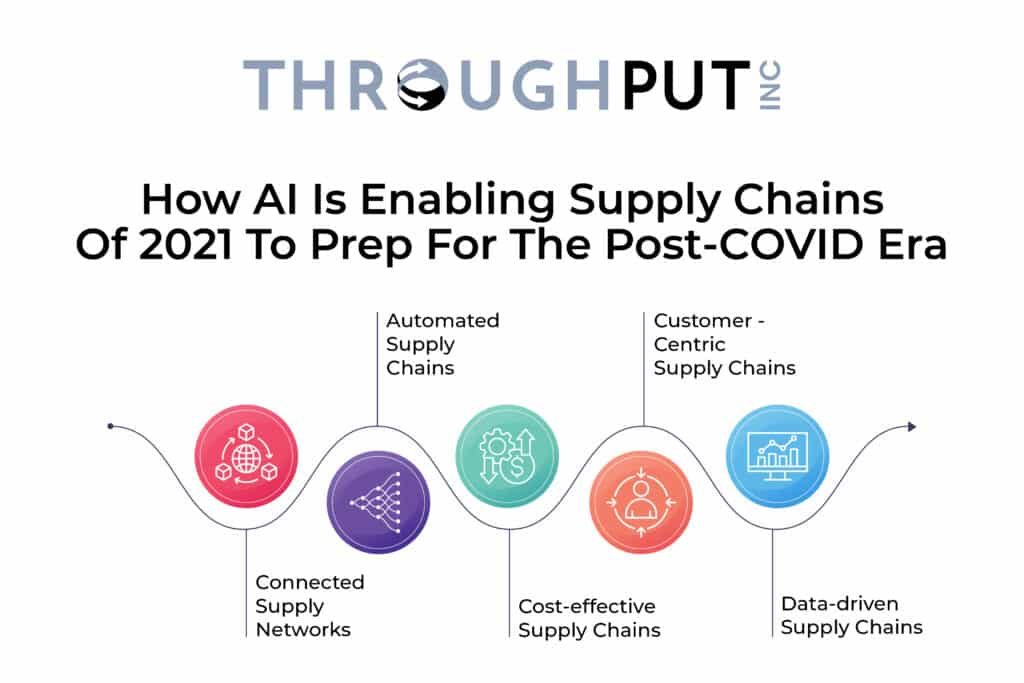Looking Beyond the Post-Covid Era – A New Horizon for 2021 Supply Chains

The COVID-19 pandemic has unearthed several long-standing vulnerabilities and risks that were predominant in global supply chains.
Some organizations have been forced to relook at their existing business value chains and models.
Some others have leaped into leveraging new growth opportunities and unique perspectives.
For few others, it has brought in a strong competitive advantage by opening up several avenues of revenue and market share.
It has touched multiple spectrums of organizational performance while not giving enough time to prepare and respond to this sudden upheaval.
As organizations gear up to face the new normal in the post-COVID world, Artificial Intelligence (AI) can be the perfect tool to help address current supply chain challenges and enable them to anticipate, sense, and respond to unexpected changes while minimizing their impacts.
Mckinsey reports that 61% of organizations have shown decreased costs and 53% have reported increased revenues as a direct result of introducing AI into their supply chains.
This along with a string of direct benefits like lower inventory-carrying costs, inventory reductions of up to 75%, and lower transportation and labor costs are among the biggest areas of savings.
Here’s How AI Is Enabling Supply Chains Of 2021 To Prep For The Post-COVID Era

1. Connected Supply Networks
Connected supply chains are focused on continuous innovation for enhancing the experience of each stakeholder in the system. This goes beyond mere supply chain visibility or integration and is more about one large connected network.
A constant flow of data and real-time insights driven by the use of AI-powered analytics ensure a two-way flow of communication in this supply chain system. Being a highly responsive and adaptive network, every node in the value chain is able to exchange these insights.
2. Automated Supply Chains
One of the biggest applications of AI in supply chain automation is helping global supply chains meet customer expectations like never before. The post-COVID world is one where customers expect rapid deliveries, 24/7 accessibility, and easy returns, all with innovative service options.
Automation equipment and predictive analytics are helping the retail and health care supply chains ensure delivery of essentials during times of emergency and helping cope with adverse conditions. Delivery at scale, speed, and accuracy is possible with automated supply chains, which is the need of the hour.

3. Cost-effective Supply Chains
AI and Machine Learning (ML) are already beginning to change the face of the supply chain industry, which will further aggravate the divide between the winners and the losers.
By culling out deep-rooted inefficiencies and uncertainties, AI drives enterprise-wide visibility into all aspects of the supply chain and this granularity is extremely important in the post-pandemic era.
AI-driven supply chains can help deliver the powerful optimization capabilities required for more accurate capacity planning, improved productivity, high quality, lower costs, and greater output, all while fostering safer working conditions.
4. Customer-Centric Supply Chains
The post-pandemic supply chain will be heavily focused on the company’s ability to satisfy customers, drive profitable growth and deliver new innovations to the market.
The customer-centric supply chain will leverage AI-driven technology to launch new products, deliver exceptional service and reduce working capital across the network. These digital supply chains will be able to better understand how to mitigate risks while uncovering opportunities for growth amid the pandemic complexities.
5. Data-driven Supply Chains
The post-COVID world would need a strong interconnected supply chain that leverages underlying data streams using digital tools and physical infrastructure.
AI, Machine Learning, and Robotics can truly enhance data utilization to boost supply chain efficiency, productivity, and safety while contributing to increased revenue streams and elimination of operational bottlenecks.
Real-time data analytics and insights can go a long way in reducing wastage in the supply value chain and contribute to accurate and faster decision-making.
Towards Resilient, Agile, and Predictable Supply Chains with AI
An important lesson that supply chains of today need to learn from the ongoing pandemic is agility. AI-driven supply chains are strong enough to absorb any shocks, overcoming possible constraints and built on models to predict future events accurately.
Resilient supply chains are smart enough to leverage relevant AI capabilities to adapt to changing market conditions and even during an emergency, are able to use real-time intelligence to provide actionable recommendations that reduce possible disruptions and mitigate risks.
A predictable supply chain cuts down unnecessary costs involved in shifting paradigms each time there is a fluctuation that affects the supply or demand cycle. It is a fact that the COVID-19 pandemic is an eye-opener and will result in pushing global supply chains to become smarter and gain complete end-to-end visibility into the upstream and downstream operations.
Click here to read the 2021 State of AI & Supply Chain and gather insightful perspectives on the impact of AI on the new-age supply chain.


